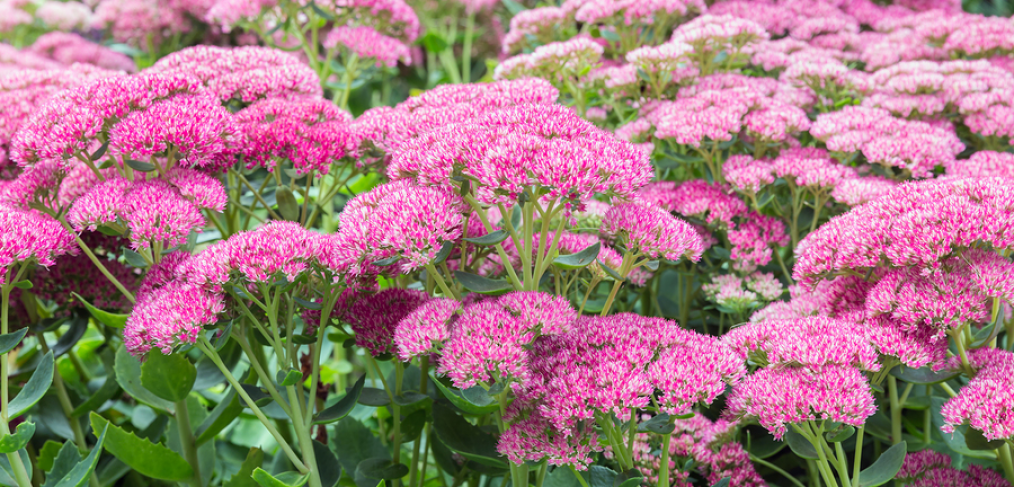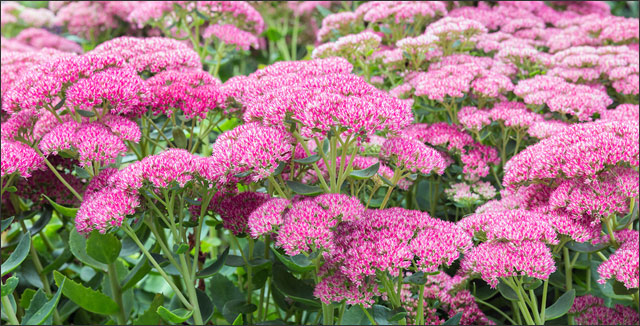
Cold Hardy Container Plants for Fall and Winter

I love learning about new plants, don’t you? It seems like, no matter what plant you choose to learn about, someone, somewhere has tried it in a new location or made it do something new. The beautiful thing about plants in human hands is that there will never be an end to the combinations that are possible. Plants do new things all the time and people continue to surprise me with their creativity.
Lately, I’ve been thinking about new things to do with container plants on my front porch. It would be nice to have something that can transition to cold weather so I don’t have to be digging in cold soil once the frost sets in. Here in Michigan, you never know when that will be. We could have snowy weather from October through May. Or we could have fairly warm weather straight through December.
9 Container Plants for Fall and Winter
Here are some ideas for container plants through cool, and into cold, weather.
Sedum
Sedum looks its best in fall. That is why it is popular to plant in fall container gardens. The other reason is that it comes in a wide array of textures, colors, and flowers. It blooms in late summer through early fall and tolerates some shade.
The best part is, you can leave it out all winter because it dries beautifully and looks wonderful covered with snow or frost. It’s hardy down to -40 degrees Fahrenheit and is a perennial in zones 3-9. Beware: sedum gets pretty tall. Plant in the back of your container for best effect.
Cabbage & Kale
I don’t know about you, but I just love cabbages and kales in container gardens. The round and leafy cabbages change color and get more intensely colored after a good frost. Kales can add a spiky, wonderful flavor to any container. Don’t be afraid to go bold and pair with another big and bold plant to last through the winter months.
Oxalis
Oxalis is a mounding plant that grows 12-18 inches high, so it’s great for filling out a container. It comes in something almost like black or burgundy – so very bold – and is hardy to 15 degrees F. However, you can also bring it inside to overwinter if you want. Oxalis vulcanicola is the species that isn’t invasive.
Verbena
This prolific bloomer looks great nearly all growing season. Many species are hardy to 15 degrees F and keep flowering after the first frost of the year. You can use them to fill a space or spill over the edge of a container. Verbena comes in many colors: reds, deep blues, purples, and pinks. This plant will need feeding every couple of weeks and pruning to prevent it getting leggy.
Wirevine
Wirevine is a gorgeous and surprising ground cover that may work well in a cold climate, as it’s a highly invasive species in mild climates. If you like the look of a button fern – which is a tropical or subtropical plant and won’t survive outside in cool climates – this could be your plant.
What makes wirevine so interesting is that it does well in crevices and can be controlled by the cold. In cold weather, the longer trailing vines will die back, causing the main plant to get thicker over time. You can use this as a beautiful ground cover over a rocky retaining wall or even train it to climb. It will eventually make a mat of plant matter, as that’s its natural growth pattern.
Salvia
Another beautiful plant is salvia with many great attributes, including cold-hardiness, is a sage, or salvia shrub. This is a huge family of plants. They attract many types of pollinators because of the nectar in their beautiful flowers. In addition, they are resistant to deer and rabbits, which would be great for Michigan as we have both in abundance.
Salvia needs full sun and a range of soils depending on what variety you have. Many varieties which bloom in the spring will re-bloom in fall if they are deadheaded after the first bloom. Cut back plants in spring only to improve their hardiness to cold. Mound up pine needles or dead leaves around the base of the plant to protect it from extreme cold.
Lamb’s Ear
Many gardeners will be familiar with this plant for its silvery and velvety soft foliage. Lamb’s ear is drought tolerant and spreads easily. This makes it a wonderful filler for gardens and container plantings alike.
When lamb’s ear blooms, it does send up 12-18 inch spikes with lavender flowers. However, the “big ears” cultivar has bigger leaves and sometimes goes many years without blooming. It is also said to be more resistant to disease.
Lamb’s ear is deer and rabbit resistant. It can be grown in full sun in northern climates and is cold hardy in relatively mild weather. If it sustains cold damage in very cold weather, the damaged leaves should be removed before new spring growth. It is also quite drought tolerant and will rot if conditions are too wet, making a container garden more ideal for this plant.
Creeping Jenny
Creeping Jenny is another one of those trailing plants that look great at the edges of container gardens. Also called “moneywort,” its bright green tendrils have little round leaves, and in some places, it is an invasive species.
The bad news is that in cold weather it does disappear completely, but it is a perennial. The good news is that it will come back in the spring, as long as you have it in a well-drained container. In milder climates, it needs to be controlled or it will take over your whole garden. It puts out tiny yellow flowers during the growing season.
Other Great Evergreens for Your Overwinter Container Plants
Here’s another list of great evergreens that will easily overwinter in your containers:
- Japanese Yew
- Potted Blue Spruce
- Boxwood Hedge
- Cypress Topiary & Cypress thread branch
- Brown’s Yew
- Winter Gem Boxwood
- Ligustrum
- English Boxwood
Takeaway
Surprisingly, the cold weather doesn’t have to dictate what you do with your garden, even if you live in a snowy zone. Use a little of that ingenuity and some cold-hardy plants, and you can enjoy green on your porch for months to come!



